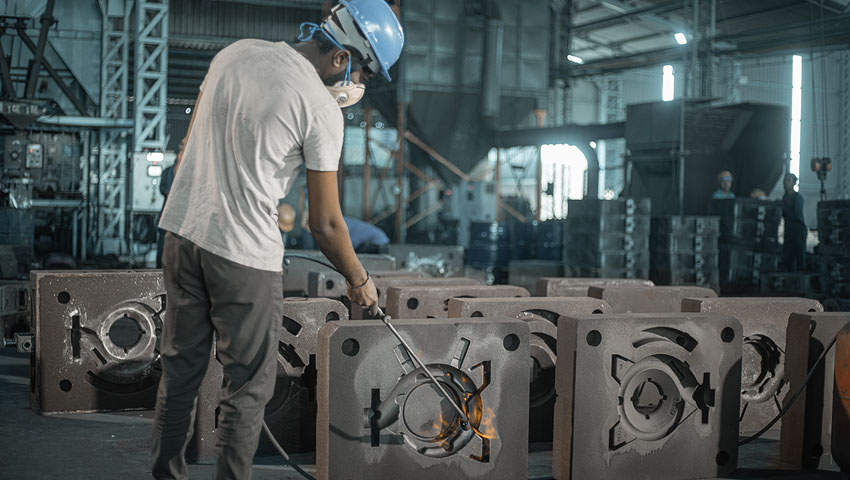Nov 29, 2025
Sep 25, 2025

Contact us today to discuss your requirements and discover how we can add value to your business.

Casting is the backbone of modern manufacturing, allowing someone to create complex metal parts used across industries of automotive, construction, agricultural and heavy machinery. Among all types of casting process, CI Casting is the most versatile, long lasting and cost effective. But it is compared to other traditional casting processes like sand casting, die casting and investment casting, each with its strength and application. Information about the difference between CI Casting and traditional casting process should be known to manufacturers and engineers so they can have effective manufacturing process and product functionality.
CI Casting or Cast Iron Casting is the process of pouring molten iron with over 2% carbon into a mold and then forming a solid part.
The process is famous for producing solid parts that are strong, wear resistant and have good machinability and is best suited for applications in engine blocks, pipes and machine parts. The most widely practiced are:
• Sand Casting: The oldest and most versatile technique, sand casting forms liquid metal in a sand mold. It is cost effective for small batches and big components but sometimes requires further processing to include the correct size measurements.
• Die Casting: In this method, molten metal is pushed at high pressure into a steel die to create extremely precise parts with fine surface finish. Best suited for high volume production of non-ferrous metals like aluminum and zinc.
• Investment Casting: Also known as lost-wax casting, in which the wax pattern is enveloped with a layer of ceramic shell to create a mold. Suitable for intricate, high precision components but slower and more costly.
• Continuous Casting: Primarily used with metals like steel, where molten metal is poured into continuous lengths like tubes or slabs with high efficiency for mass-produced everyday products but with very limited design flexibility.
All these processes are used in manufacturing but are very different from CI Casting in process and material used and product attained.
1. Composition of Material
CI Casting is tailored for casting iron, which contains a high percentage of carbon (2–4%) and silicon (1–3%) with special properties like fine castability and wear resistance.
Traditional cast processes like investment casting and die casting typically employ non-ferrous metals like aluminum, zinc, or copper alloys having lower melting points and different mechanical characteristics.Sand casting, being flexible enough to accept cast iron, is also used for a greater range of metals like steel and bronze. CI Casting material specificity is applied in thermal conductivity and durability purposes, such as by Sagar Foundry for the production of motor vehicle and industrial components.
2. Preparation and mold material
The most common mold material of CI Casting that are cost-effective and versatile for large or complex parts are green sand (mixture of clay, sand, and water) or dry sand. Sand molds are created by compacting sand over a pattern that is then removed to create a cavity for iron molten metal.
Die casting, on the other hand, uses reusable steel dies that are expensive to produce but enable high-speed, high-volume production. Investment casting uses expendable ceramic molds that produce intricate shapes but increase cost and lead times. Continuous casting utilizes water-cooled metal dies to cast continuously, with some being used for simpler forms. Sagar Foundry’s skill in the making of sand molds creates precise patterns and quality CI castings.
3. Cost Considerations
CI Casting is typically cost-effective in small to medium-scale production runs on the assumption that sand molds are low in cost and cast iron components are very resistant to replacement. Die casting involves great initial investment in steel dies but is cost-effective in mass production.
Investment casting is expensive because it is time-consuming and investment casting is ongoing, being cost-effective for repetitive parts but costly to establish. Sagar Foundry’s improved CI Casting process saves cost while delivering high-quality parts, providing a cost-effective option for industries like automobile and agriculture. Applications of CI Casting versus conventional casting CI Casting has widespread uses in automobile (engine blocks, cylinder heads), construction (pipes, fittings), and agricultural (machine parts) sectors according to its strength as well as economy.
Conventional casting has broader applications: casting of big industrial components by sand, die casting of automotive and consumer electronics sectors, investment casting of high-precision components like turbine blades, and continuous casting of steel billets and pipes. CI Casting experience of Sagar Foundry ensures components to the strict standards of such industries.
Conclusion
CI Casting and traditional casting operations both have their own distinct advantages appropriate to a specific production need. CI Casting stands out in its long lifespan, flexibility, and affordability, especially for cast iron parts in critical applications. Investment casting and die casting are traditional processes that offer accuracy and agility for high-value or intricate parts, while continuous casting and sand casting offer flexibility and high efficiency. With such differentiation, manufacturers are able to make their production process smooth and effective, as well as get improved success rates.